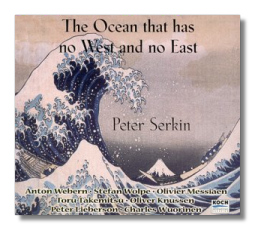
The Internet's Premier Classical Music Source
Related Links
- Latest Reviews
- More Reviews
-
By Composer
-
Collections
DVD & Blu-ray
Books
Concert Reviews
Articles/Interviews
Software
Audio
Search Amazon
Recommended Links
Site News
 CD Review
CD Review
The Ocean That Has No West and No East

- Anton von Webern:Variations Op. 27
- Stefan Wolpe:
- Toccata
- Pastorale
- Rag-Caprice
- Form #4: Broken Sequences
- Olivier Messiaen: Cantéyodjayâ
- Tōru Takemitsu:
- Rain Tree Sketch (1982)
- Rain Tree Sketch II (1992)
- Oliver Knussen: Prayer Bell Sketch Op. 29 (In Loving Memory Of Tōru Takemitsu)
- Peter Lieberson:
- The Ocean Has No East And No West
- Fantasie
- Charles Wuorinen: Bagatelle
Peter Serkin, piano
Koch International Classics 3-7450-2H1 DDD 78:00
Peter Serkin recorded these works over the course of more than three years, between 1994 and 1997. It seems that these recordings originally were intended for release on the BMG Classics label, for which Serkin has recorded extensively. However, Koch International has licensed them from BMG, leading me to wonder whether BMG was worried that a program such as this one could not be a big-seller. An earlier BMG CD with similarly challenging repertoire (… in real time, BMG Classics 09026-68189-2) won kudos from the critics, but it goes without saying that these are not Three Tenors sorts of "classical" CDs, at least in terms of sales. Like its predecessor, the present disc demands active mental participation from its listeners. The effort is nothing like the effort that Serkin put into it, of course!
In spite of its long gestation time, and the diversity of composers and compositional styles, this CD holds together very well. The opening Webern Variations for Piano, a seminal piece of 12-tone writing from 1936, seem almost old-fashioned in this company. They are followed by four works by Stefan Wolpe. Pastorale (1939), Rag-Caprice (1927), and Form IV: Broken Sequences (1969) are aphoristic, and they have the tense humor of a painting by Max Ernst. The 1941 Toccata is more expansive, and is a real tour de force of flying notes, fingers, and elbows – a tornado at play over the keyboard. The savage Cantéyodjâya (1948) is one of the first masterpieces of Olivier Messiaen's mature style. It's no less technically demanding than Wolpe's Toccata, but its tightly wound rhythmic complexities are very different from Wolpe's flights of fancy (even though the Toccata ends with a fugue!)
From Messiaen to two works by Tōru Takemitsu is a jump of several decades and stylistic trends, yet there are undeniable affinities between the two composers. Rain Tree Sketch (1982) and Rain Tree Sketch II (1992) are finely tooled miniatures, both delicate and concentrated. The latter was written in memory of Messiaen, who died that year. Takemitsu himself died in 1996, and composer Oliver Knussen paid tribute to him the following year with a work titled Prayer Bell Sketch. Knussen's exquisite memorial is more than an imitation of Takemitsu's style; it's an homage that amplifies it by an order of magnitude. Another Takemitsu tribute is the one that gives this CD its title. Peter Lieberson's The Ocean that has no West and no East (1997) is described by the composer as an elegy, but there is nothing mawkish about it. It is evocative, pictorial, and haiku-like in its economy – much is done with little, but there is no feeling of pressure.
Two 10-minute pieces close the CD. Lieberson's Piano Fantasy (1974-5) is an explosion of color and light. It is hard to believe that one pianist is responsible for all these sounds. The Bagatelle (1987-8) by Charles Wuorinen belies its name, not just in its length, but in its impact. Although Beethoven's works in this genre were short, they had very "long" implications. Wuorinen's work is not as gnomic as Beethoven's. Nevertheless, it makes a compelling statement with its suspenseful stillness. Everything seems slowed down in this music. Rather than painful, the effect is one of pleasant waiting… for who knows what?
Serkin's technique allows him to negotiate dense thickets of notes and impossibly tangled rhythms without audible strain. He is slightly less convincing when he moves to the other extreme and is asked to spellbind the listener with almost imperceptibly small and slow musical changes. What is most impressive about Serkin, however, is his dedication to this repertoire. There are not many pianists who would stick their necks out for music that doesn't receive the sympathy usually reserved for Mozart, Beethoven, Chopin, Debussy, and the like. Prove me wrong and hear this CD.
The engineering is good, although one can detect differences from session to session in details such as Serkin's breathing. This was not a distraction for me.
Copyright © 2000, Raymond Tuttle


















